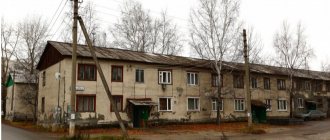Yesterday, the State Duma of the Russian Federation adopted in the 3rd reading changes to the law on state registration of real estate. It is expected that after it comes into force (February 1, 2022), it will become easier for citizens to obtain information about the technical condition of their home. Authorities and local governments will transmit to Rosreestr data on the recognition of a house as unsafe and subject to demolition or reconstruction. Citizens will see this information based on an extract from the Unified State Register of Real Estate. We tell readers where they can view this information right now.
What applies to non-residential properties?
Any objects in which permanent residence is not possible are considered non-residential:
- Detached buildings.
- Premises inside apartment buildings.
- Office premises and centers.
- Individual structures are isolated objects.
The main condition is the relationship of the building to the non-residential stock.
For example, in apartment buildings, the first floors may be given over to shops and cafes, and they are considered non-residential. The apartments on the second floor are residential.
Note! If the apartment owners themselves applied to the interdepartmental commission to recognize the house as unsafe, the owner of the non-residential premises does not have to submit documents. In any case, the house is recognized as unsafe only together with all the premises located in it.
Where can I find out the timing and procedure for relocating emergency houses?
Each region creates and maintains a database of dilapidated and emergency housing throughout its territory. You can clarify the list of houses included in the resettlement plan directly from the local administration or on the regional website of the regional government authority.
In addition, a federal register of such houses is maintained, which is freely available on the official website “Housing and Communal Services Reform”, where you can find the following information:
- a general database for houses for which there are complaints from citizens about the poor condition of the housing stock and quality control is carried out;
- a list of residential buildings recognized as dilapidated and unsafe, included in the lists for relocation and demolition (for each region separately);
- information about the housing stock under construction as part of the resettlement of residents of houses included in the federal resettlement program, as well as about residential buildings already built and put into operation under the specified program;
- statistics on activities already carried out in accordance with regulations;
- view frequently asked questions on this topic and their answers;
- find out whether your house is on the list of those subject to resettlement, by address, and clarify the planned date of events.
Emergency building: what is it?
The emergency condition of a building is a condition in which the presence of people in it is unsafe:
- Significant damage to load-bearing and other structures as a result of temporary wear and tear: malfunction of ventilation or sewer systems, engineering components, collapse of walls.
- Finding an object in a dangerous zone: with increased radiation radiation, exposure to electromagnetic fields.
- Damage to the premises as a result of an explosion or accident.
The owner or administration has the right to initiate recognition of non-residential premises as unsafe. If, based on the results of the inspection, it is determined that the object can be returned to normal condition through repairs, it will not be recognized as an emergency, but it will be obligated to repair it and make sure that there is no danger of collapse for other people.
The difference and advantages of dilapidated housing over emergency
Recognition of a private house as unsafe and subject to demolition
Signs of an accident
Decree of the Government of the Russian Federation of 2021 No. 577 establishes the rules for recognizing non-residential premises as unsafe. The document regulates the procedure for recognizing as emergency any non-residential facility of a capital structure, regardless of the form of ownership.
Expert opinion
Stanislav Evseev
Lawyer. Experience 12 years. Specialization: civil, family, inheritance law.
Only a local government body can initiate the demolition process of a non-residential structure. The reason must be the poor technical condition of the premises. The basis for dismantling is the measures of the district administration for the integrated development of the territory.
In order for a non-residential premises to be recognized as unsafe and subject to demolition, one or more of the following conditions must be met:
- high physical wear and tear of the structure as a whole or its parts;
- location of the premises in areas with a high level of danger (areas of mudflows, avalanches, slides, floods);
- destruction of the premises or its parts due to fire, explosion, earthquakes;
- location of the building in the area of man-made disasters.
A prerequisite for recognition as an emergency is the economic inexpediency of carrying out major repairs.
Recognition of a building as unsafe: legislation
The Civil Code and Housing Code of the Russian Federation say nothing about the features and procedure for recognizing a non-residential property as unsafe. Therefore, there are often disputes in the courts, and the answers to these questions are contained only in local legislation. But there is a Determination of the Supreme Court of the Russian Federation dated November 20, 2021 in case No. 309-KG18-13252, which says that one must be guided by laws governing similar issues regarding residential premises:
- Clause 10 Art. 32 Housing Code of the Russian Federation. The body that made the decision to recognize the building as unsafe has the right to present a demand to the owner for demolition within the established time frame.
- Art. 279 of the Civil Code of the Russian Federation. The land plot on which the emergency building is located may be seized for municipal needs. An agreement is concluded with the owner on this, and monetary compensation is paid to him. If he refuses to formalize the agreement, the land is confiscated by court decision.
- Art. 56.3 of the Land Code of the Russian Federation. A land plot can be withdrawn regardless of the form of ownership: right of perpetual use, lease agreement, right of ownership, etc.
The most important is Art. 6 Civil Code of the Russian Federation. It says: if specific property relations are not regulated by civil law, the rules of civil law governing similar relations are applied to them.
What is the procedure for recognizing housing as unsafe?
Previously, houses were recognized as unsafe based on a decision of an interdepartmental municipal commission. In accordance with the Decree of the Government of the Russian Federation of November 29, 2021 No. 1535 “On amendments to the Regulations on recognizing premises as residential premises, residential premises unsuitable for habitation...”, an examination is now required for the conclusion. It is carried out by specialized organizations that have the right to carry out work to examine the condition of the soils of the foundations of buildings, structures and their building structures.
Subsequently, the interdepartmental commission, within three days, sends the results of the examination to the relevant federal government body, the executive body of the constituent entity of the Russian Federation, as well as the local government body for decision-making. In addition, the results of the examination are received by the applicant and (or) the state housing supervision body (municipal housing control) at the location of the premises or apartment building.
The procedure for recognizing a building as unsafe
The procedure for recognizing a non-residential building as unsafe is as follows:
- The owner or administration applies to an interdepartmental commission specializing in conducting an examination of the technical condition of the building for compliance with the requirements of Federal Law dated December 30, 2009 No. 384-FZ “Technical Regulations on the Safety of Buildings and Structures.”
- An examination is carried out, the initiator is given an inspection report, on the basis of which a conclusion of the interdepartmental commission is drawn up. Employees of the Ministry of Emergency Situations, Rospotrebnadzor and other departments can participate in the survey.
- The initiator submits the application and other documents to the property relations committee or another organization authorized to review documents.
- The committee reviews the documents within 20 days and issues a decision to recognize the building as unsafe or to refuse it.
After this, the structure is included in the list of non-residential facilities in disrepair. The owner is paid compensation.
Sample act
Contents and sample application
The application shall indicate the following information:
- Full name, address of the applicant.
- Name and address of the organization to which it is sent.
- Address of non-residential property.
- Request to recognize a non-residential building as unsafe.
- Description of submitted documents.
- Date of registration and signature.
Sample application
Application for recognition of a house as unsafe and subject to demolition or reconstruction
Documentation
When applying to the commission you will need:
- statement;
- passport;
- extract from the Unified State Register of Real Estate;
- the document on the basis of which the ownership right arose;
- cadastral passport;
- registration certificate
Important! The list of documents may vary depending on the type of non-residential real estate.
Expenses
There is no fee for recognizing non-residential premises as unsafe. But the owner will have to bear the costs of its demolition if the land plot on which it is located is not seized for municipal needs. The agreement may provide for compensation of expenses.
Consequences of declaring a building unsafe
If a person used non-residential premises on the basis of a lease agreement, another building is not provided to replace him. The contract is terminated from the moment the object is recognized as unsafe. The owner can receive monetary compensation for the cost of the site.
Who can decide whether to recognize houses as unsafe?
The new rules are outlined in the Decree of the Government of the Russian Federation dated April 24, 2021 No. 581 “On amending paragraph 7 of the Regulations on recognizing premises as residential premises, residential premises unsuitable for habitation, an apartment building in disrepair and subject to demolition or reconstruction, a garden house as a residential building and a residential building garden house."
Question and answer How can residents of a dilapidated house stop paying for major repairs?
In this document, the government clarified who makes the decision to recognize a residential premises as unfit for habitation, and an apartment building as unsafe and subject to demolition or reconstruction.
The resolution states that if an assessment is carried out on objects of the housing stock of the Russian Federation, as well as an apartment building located in federal ownership, then the decision is made by the federal executive body exercising the powers of the owner of the property. If the property belongs to a federal executive body or its subordinate enterprise (institution), then the decision is made by this body.
Arbitrage practice
There is no legislative regulation of the issue of recognition of non-residential premises, and therefore confusion often arises. The Housing Committee may refuse to accept documents, citing lack of authority. It is necessary to look at regional laws, but taking into account the norms specified in the Civil Code, the Housing Code and the Land Code of the Russian Federation.
Often, even the courts refuse to satisfy the claims of property owners to recover compensation from the municipality, saying that it is due only to the owners of residential properties. At the same time, they forget about the norms of Art. 35 of the Constitution of the Russian Federation, according to which, even in case of forced alienation of property, compensation must be paid to the owner.
Here are some examples of solutions on the topic:
- Decision No. 2-2902/2014 2-2902/2014~M-2508/2014 M-2508/2014 dated November 27, 2014 in case No. 2-2902/2014.
- Appeal decision No. 33-1447/2015 dated January 28, 2015 in case No. 33-1447/2015.
- Decision No. 2A-1472/2019 2A-1472/2019~M-1068/2019 M-1068/2019 dated June 14, 2021 in case No. 2A-1472/2019.
The Housing and Communal Services Fund spoke about new mechanisms for relocating dilapidated houses
The mechanism for integrated development of territories should become a powerful tool for relocating emergency housing, Rurin emphasized. Now in the territories where integrated development is planned, there are three types of houses - about 10% are buildings recognized as unsafe before 2017, 15% are houses recognized as unsafe from 2021 to 2021, and 75% are dilapidated housing. The Fund proposes to ease restrictions on the subsequent use of land under demolished dilapidated houses, if this is an area of integrated development. In addition, it is proposed to separate the financing of integrated development from the usual resettlement of dilapidated houses.
This year, decisions have already been made to allocate funds for the integrated development of two territories - in Mari El and the Murmansk region. Eight more projects are expected to be approved by the end of the year, Rurin said. In general, 30 such projects may appear in the near future, and by the end of next year their number may grow to 90.
The Foundation also plans to develop rental housing. Although this option is already legally possible, not a single rental housing project has taken place in more than a year. “We believe that additional efforts can be made to make this mechanism work, begin to develop, and even, perhaps, become one of the key mechanisms for the implementation of this program,” Rurin noted. This property will be owned by municipalities or regions and will generate income, even if preferential rates are expected to apply. “We consider it possible to use repayable funds, for example, from the National Welfare Fund, to create rental housing,” said Rurin.
In addition, the Fund intends to analyze decisions to recognize houses as unsafe. Many of them do not comply with the law - there are not enough conclusions from specialized organizations; sometimes Soviet-era standards are used to assess the condition of houses.
It is also planned to proactively finance the resettlement of housing recognized as such after 2021 (according to the main program, houses that became unsafe before the end of 2016 are resettled). So, on Friday the first application for financing the liquidation of such housing from Sakhalin will be considered. The region completed the program for eliminating dilapidated houses ahead of schedule; it is proposed to use the remaining funds for the next dilapidated houses. In total, four regions have already completed the program, and five more are due to complete it by the end of the year. In March next year, these regions are expected to receive funds for new resettlement; the draft budget includes 45 billion rubles for this.
These initiatives are still under discussion, the Housing and Communal Sector Reform Assistance Fund emphasizes.
Lawyer's answers to private questions
What to do if the premises are refused recognition as unsafe?
The conclusion of the MVK may indicate a refusal to recognize a non-residential building as unsafe, and this decision can be appealed in court. In this case, the commission will be required to conduct a re-inspection, or the premises will be declared unsafe by a court decision.
I was paid compensation for the demolition of a dangerous building. Is it subject to personal income tax?
Yes, it is taxed at 13%, and the administration becomes the tax agent. She independently pays personal income tax for the former owner. If, instead of compensation, other premises are provided, its market value is included in the base.
Can they provide another premises instead of a non-residential one recognized as unsafe?
Most often no, it depends on the region. Typically, a specialized fund is calculated only for owners of residential buildings and apartments. But they can also provide another room or building, if possible. This is not prohibited by law.
The house was declared unsafe, my store is on the first floor. The administration obliges you to move in within the established time frame. Can I not leave my premises?
Theoretically, you can, but according to the law, the administration will file a claim for the forced vacation of non-residential premises, and then it will have to be vacated, accompanied by bailiffs.
How to recognize garages as unsafe in GSK? What is needed for this?
To recognize garages in the GSK, an application from several owners or tenants is required.
On the Housing and Communal Services Reform website
Here you can find more detailed information on houses recognized as unsafe. On the page with the emergency fund, enter the address of the house - city, street name, house number (without “g.”, “d.”, “street”). The search engine will prompt you to the desired address if the house is in the system. Open the page with the house and click the “Resettlement of emergency housing” tab.
This tab shows when the house was declared unsafe, when the municipality wants to resettle it, and the general degree of deterioration of the building.










